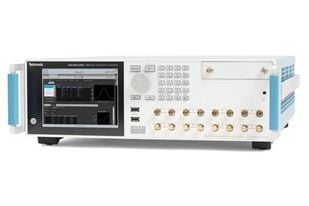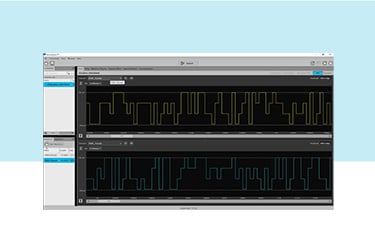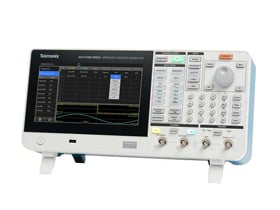연락처
텍트로닉스 담당자와 실시간 상담 6:00am-4:30pm PST에 이용 가능
전화 문의
9:00am-6:00PM KST에 이용 가능
다운로드
매뉴얼, 데이터 시트, 소프트웨어 등을 다운로드할 수 있습니다.
피드백
임의 파형 발생기
Tektronix 임의 파형 발생기 제품군은 최대 50GS/s의 샘플링 속도, 최대 8개의 채널 및 이 같은 복잡한 신호를 손쉽게 만들 수 있는 소프트웨어 패키지를 통해 최고의 성능을 제공합니다. 유연성, 속도 및 충실도가 탁월한 Tektronix 임의 파형 발생기는 고속 시리얼, 광학 통신, 레이더 테스트 및 전자전에 이상적인 솔루션입니다.
용도에 알맞은 파형 발생기 찾기
관련 제품
Tektronix 임의 파형 발생기의 주요 특징
Tektronix 임의 파형 발생기는 복잡한 RF 신호를 생성하고 단일 장비에서 실시간 환경을 시뮬레이션할 수 있는 완벽한 솔루션입니다. Tektronix 임의 파형 발생기를 사용하면 다음을 수행할 수 있습니다.
- 여러 장비의 동기화를 통한 멀티 채널 및 고속의 AWG
- AWG 전면 패널을 통한 빠른 파형 선택, 편집 및 재생과 이벤트 트리거
- 오실로스코프 또는 실시간 스펙트럼 분석기에서 포착한 신호의 재생, 편집 또는 재샘플링을 통한 실제 환경의 시뮬레이션
- MATLAB 등 타사 도구의 파형 벡터 가져오기
임의 파형 발생기를 사용한 레이더 신호 생성 정복하기
복잡한 레이더 신호를 생성하는 일은 어려운 작업일 수 있습니다. 이 25분 분량의 영상에서 프로세스를 더 효율적으로 만드는 방법에 대해 알아보십시오. 이 프리젠테이션에는 신호 생성 코드 작성 및 디버깅의 번잡함을 줄이는 방법과 복잡한 신호를 생성할 때의 주의점에 대해 알아봅니다.
파형 발생기 자주 묻는 질문(FAQ)
What is a waveform generator?
A waveform generator is a piece of electronic test equipment used to generate a variety of electrical signals. These signals act as a stimulus to a device under test (DUT), allowing engineers to verify a circuit's performance, troubleshoot issues, or simulate real-world conditions. The types of signals can range from simple, standard waveforms to complex, user-defined patterns.
What is the difference between a waveform generator and an arbitrary waveform generator (AWG)?
A waveform generator is a general term that refers to any instrument capable of producing electrical waveforms. This includes both function generators (also known as AFGs—Arbitrary Function Generators) and arbitrary waveform generators (AWGs). The key difference lies in waveform flexibility and complexity:
Function Generators / AFGs typically produce standard waveforms such as sine, square, triangle, and pulse. Some may offer limited arbitrary waveform capabilities, but they are generally optimized for ease of use and basic signal generation.
Arbitrary Waveform Generators (AWGs) are more advanced instruments designed to generate highly complex, user-defined waveforms with precise control over timing, amplitude, and shape. They are ideal for simulating real-world signals, such as sensor outputs, communication protocols, or distorted waveforms used in stress testing.
파형 발생기는 어떻게 사용하나요?
임의 파형 발생기는 사용자 친화성이 뛰어나 몇 단계만에 회로의 설계를 테스트할 수 있습니다.
- 출력 제어를 활성화합니다.
- 정형파, 구형파 또는 임의 파형 등 원하는 파형을 선택합니다.
- 파형 발생기를 오실로스코프에 연결해 신호를 시각화하고 포착합니다.
- 원하는 주파수와 진폭을 구성합니다.
- 출력 리드선을 테스트 대상 장치에 연결합니다.
함수 발생기와 파형 발생기의 차이점은 무엇인가요?
함수 발생기에는 재생할 수 있는 파형 또는 패턴의 사전 설정된 목록이 있습니다. 작업자는 재생 속도, 진폭 및 오프셋과 같은 파형의 파라미터를 변경하거나, 기본적인 왜곡 또는 변조를 추가할 수 있습니다.
임의 파형 발생기는 상상하는 거의 대부분의 파형을 생성할 수 있는 더욱 복잡한 장비입니다. 임의 파형 발생기는 기본적으로 AC 신호의 지속 변동 전압 레벨에 대해 알려주는 저장된 디지털 데이터에 따라 파형을 전달하는 정교한 재생 시스템입니다. 이러한 장비는 보통 미리 설정된 일반적인 파형이 아니라 컴파일된 사용자 정의 파형을 생성할 때 사용됩니다.
신호 발생기의 유형
신호 발생기의 종류에는 함수 발생기, 임의 파형 발생기, 벡터 신호 발생기 등 다양한 종류가 있습니다. 여기서 사용되는 용어의 명확한 정의를 알아보고 각 유형의 신호 발생기 간의 차이점을 알아보려면 아래의 차트를 참조하십시오.
| 신호 발생기 | 아날로그 및 디지털 전자 신호 소스의 일반 범주 이름입니다. |
| 함수 발생기 | 신호 발생기는 일반적으로 사인, 파, 삼각파 등과 같은 일반적인 파형이 필요할 때 사용됩니다. |
| 임의 함수 발생기 | 함수 발생기는 임의로 컴파일된 파형을 지원합니다. |
| 임의 파형 발생기 | 임의 파형 발생기는 (미리 설정된 일반적인 파형이 아닌) 컴파일된 사용자 정의 파형이 필요할 때 주로 사용됩니다. |
| RF 신호 발생기 | RF 신호 발생기는 무선 애플리케이션에 사용되며, 일반적으로 AM, FM 및 PM과 같은 정상적인 아날로그 변조를 제공합니다. |
| (RF) 벡터 신호 발생기 | RF 벡터 신호 발생기는 디지털 통신 애플리케이션을 위한 RF 캐리어에서 아날로그 및 벡터 변조 모두를 지원합니다. |









